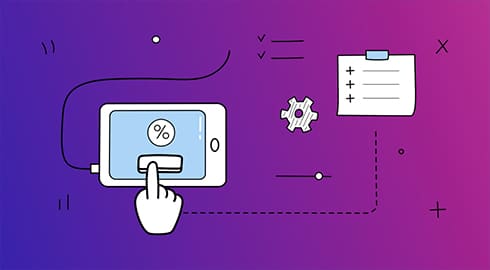Both sales tax and use tax fall under the umbrella of indirect taxation. Think of them as hot potatoes. Both are triggered when a good or service is bought, but where it’s bought will determine who the hot potato is passed on to. One hot potato is easy to keep track of. But if you’re a growing business with a customer base expanding across multiple states, that’s a lot of hot potatoes to keep track of.
The best way to understand the difference between sales tax and state use tax is to explore each concept individually. After that, we’ll compare them side-by-side to understand the difference once and for all.
Let’s start with the tax everyone already knows…
What is Sales Tax?
It’s a single-stage tax applied only at the point of retail sale to the final consumer. The total tax burden is visible to the end consumer as it’s added to the sale price at purchase.
What is the sales tax rate?
Typically, a percentage of the purchase price varies by location and the type of product being sold.
What items are taxable?
Tangible Personal Property
These are goods you can physically touch, like clothing, furniture, electronics, vehicles, food & beverages, building materials, fuel & energy, and certain agricultural products. Sales tax is collected at the point of sale and calculated at the state sales tax rate.
Services
This includes activities performed for a fee. Things like legal & accounting, engineering & architectural, repair & maintenance, personal services, entertainment, accommodation, and telcos. Taxability and rates depend on the state & service type.
Digital Products
These taxable items are defined as intangible goods delivered electronically. We’re talking software, e-books & audiobooks, streaming services, mobile apps, games, and online courses. Taxability can vary significantly between states, complicating compliance, especially for SaaS companies.
Who collects sales tax?
The duty falls on the seller or retailer to collect sales tax at the point of sale and remit it to the government.
What makes it difficult for companies to stay compliant?
There are over 13,000 sales tax jurisdictions in the US. This includes all 50 states, over 3000 counties, and almost 19,500 US cities (incorporated places). And don’t forget there are over 38,500 independent special districts – created for a specific purpose, such as schools or roads, which may have their own sales tax.
Complyt tip: How do you know if your business is subject to sales tax?
Does sales tax apply to digital products?
The answer depends on four factors.
Factor |
Impact on Sales Tax for Your Digital Products |
| Type of product | Some digital products are taxable in certain states, while others are not |
| State of sale | Each state has its tax laws; some exempt digital products from tax |
| Seller’s location | Sellers in some states must collect sales tax on digital products |
| Buyer’s location | Some states require use tax on digital products from out-of-state sellers |
How does triggering economic nexus complicate sales tax compliance?
Economic nexus refers to the criteria under which businesses must collect sales tax based on their economic activity in a state, regardless of your company’s physical presence.
Here are four ways that economic nexus complicates sales tax compliance
1. The complexity of over 13,000 tax jurisdictions
The US sales tax system spans 13,000+ tax jurisdictions, including states, counties, and cities. Businesses dealing with varied rates and rules across locations risk errors and non-compliance when navigating this bureaucratic maze.
2. Triggering threshold variation
Economic nexus thresholds vary by state, and meeting these thresholds can lead to sales tax obligations. For example, the economic nexus threshold in New York is $500,000 in sales, triggered when a company makes more than 100 transactions.
3. Reporting and remitting requirements
Once a business has triggered economic nexus, it must register with the appropriate tax authorities and collect, report, and remit sales tax on its sales. This can add to the complexity of sales tax compliance and may require additional resources or expertise.
4. Consequences of non-compliance
Failing to identify and address economic nexus can lead to penalties and legal consequences, as businesses are responsible for staying compliant with tax regulations in all relevant jurisdictions.
How do you know you’ve established economic nexus?
Let’s say…
- You’re a SaaS company based in California (7.25% sales tax)
- You have over 100 clients based in New York (4% sales tax)
- Each client has purchased a SaaS subscription for $1,000 per month
- Your company has exceeded $300,000 in sales revenue from New York clients
How do you know when your business has a sales tax obligation on a purchase? Ask three questions:
-
Is the service taxable in the state?
Yes. Most SaaS services are considered taxable in New York.
-
Have I established economic nexus in the state via total sales?
No, your company hasn’t exceeded the economic nexus threshold in New York yet, where the economic nexus threshold is $500,000.
-
Have I established economic nexus in the state via total sales?
Yes, your company has exceeded the economic nexus threshold in New York, which is established when a company makes more than 100 transactions.
Since your sales are below the $500,000 threshold, you don’t have to register with the New York State Department of Taxation and Finance or remit and collect tax on your sales in New York.
What is Use Tax?
It ensures that the same tax is paid regardless of where the purchase occurs. A use tax is imposed by each state on the use, storage, or consumption of tangible personal property or taxable services where sales tax hasn’t been paid.
When is Use Tax applied?
Tangible personal property purchased outside a state with nexus and brought into the state for use. You may owe use tax on items you buy online, through mail order, or from out-of-state retailers.
What is the use tax rate?
Use tax is generally the same rate as the local sales tax rate.
When is use tax applied?
Use tax is levied on goods and services that weren’t taxed at the point of sale. This typically applies in two main scenarios:
1. Purchases from Out-of-State Sellers
When you make purchases from out-of-state retailers, such as buying products online or through mail order, these sellers may not collect sales tax during the transaction. In such cases, you, as the buyer, may be required to calculate and remit the corresponding use tax.
Another scenario is acquiring a vehicle from a dealer located in a different state and then registering it in your home state. This type of cross-border transaction can trigger the application of use tax to ensure appropriate taxes are paid.
2. Purchases Exempt from Sales Tax and Gifts
Use tax obligations can also arise when you make purchases exempt from sales tax in your state. For instance, if you buy a service that isn’t subject to sales tax, such as professional services or legal fees, you may need to report and pay use tax.
Similarly, use tax may apply when you purchase tangible personal property that falls under exemptions from sales tax in your state, like groceries or prescription medication. These exemptions can vary between states.
Lastly, if you receive a gift of tangible personal property that wasn’t taxed initially at the point of sale, such as a family heirloom or a gift from a friend, you may be responsible for paying use tax on the item when you use, store, or consume it within your state.
Who collects use tax?
The consumer is responsible for calculating and remitting use tax to the government. It is usually paid through an annual tax return.
Use Tax is more straightforward to understand when you know why it exists
With the rise of online commerce, use tax helps level the playing field between in-state and out-of-state retailers. If it wasn’t there, out-of-state sellers could offer lower prices by avoiding sales tax, unfairly disadvantaging in-state businesses. Ultimately, Use Tax protects local economies and jobs. It also funds essential public services like education, infrastructure, and emergency services.
It also simplifies tax administration by applying a single tax rate to all purchases, regardless of where they were made. It promotes fairness and equity within the tax system by discouraging individuals from seeking tax havens.
What’s the difference between sales and use tax?
Sales tax and use tax are both important sources of revenue for state and local governments. Still, they serve different purposes and are applied under other circumstances.
Here are the key differences between sales tax and use tax.
Feature |
Sales Tax |
Use Tax |
| Triggering event | Purchase of goods or services | Storage, use, or consumption of goods purchased without paying sales tax |
| Collection responsibility | Seller | Consumer |
| Payment timing | Point of sale | When filing a state income tax return |
| Compliance responsibility | Seller/retailer | Buyer/consumer |
What is the main difference between the two taxes?
Use and sales tax differ most in how they’re triggered and who the responsibility falls on to collect that tax.
Sales tax is triggered at the point of purchase. It’s the familiar price increase we see when buying groceries, clothing, or other goods and services. The seller collects this tax from the customer and remits it to the appropriate state or local government.
Use tax, on the other hand, acts as a “back-up” mechanism. It’s triggered when a purchase is made when no sales tax is paid, typically on items acquired from out-of-state vendors. The consumer is responsible for reporting and remitting the use tax to the state where the item is used or stored.
It’s a simple distinction in the end. Understanding the key differences ensures companies and individuals stay compliant and avoid potential penalties.
Stay audit-ready across 13,000+ tax jurisdictions – with Complyt
Complyt’s streamlined approach to monitoring, calculating, and remitting sales tax across the U.S. makes maintaining compliance with intricate and evolving tax regulations achievable – and effortless.
Book your demo or free tax assessment today.









